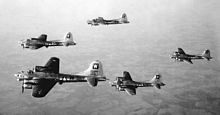RAF Sudbury
| RAF Sudbury USAAF Station 174 | |
|---|---|
| Sudbury, Suffolk, England | |
 Sudbury Airfield - 8 July 1945 | |
| Type | Royal Air Force station |
| Code | SU |
| Site information | |
| Owner | Air Ministry |
| Controlled by | |
| Site history | |
| Built | 1943 |
| In use | 1944-1945 |
| Battles/wars | European Theatre of World War II Air Offensive, Europe July 1942 - May 1945 |
| Garrison information | |
| Garrison | |
| Occupants | 486th Bombardment Group |


Royal Air Force station Sudbury or more simply RAF Sudbury is a former Royal Air Force station located 2 miles (3.2 km) north-east of Sudbury, Suffolk, England.
History
USAAF use
RAF Sudbury was opened in 1944 and was built to the standard Class A heavy bomber airfield with three intersecting concrete runways of standard lengths with Fifty hardstands and two T2 hangars to meet the USAAF bomber requirements. The airfield had a slight gradient towards the north-east and was constructed on what had been farmland. Most of the temporary building accommodation for some 3,000 men was situated around the village street of Great Waldingfield to the east of the airfield and accessible by crossing the B1115 road from Sudbury to Lavenham. The facility was used by the United States Army Air Forces Eighth Air Force. Sudbury was given USAAF designation Station 174[1] (SU).[2]
486th Bombardment Group (Heavy)
The 486th Bombardment Group (Heavy) arrived from Davis-Monthan AAF, Arizona during March 1944.[3] The 486th was assigned to the 4th Combat Bombardment Wing, and the group tail code initially was a "Square-O". When the group converted from B-24s to B-17s during the summer of 1944, the Group ID was changed to "Square-W", perhaps to avoid confusion with the Square-D on B-17s of the 100th Bomb Group. The 486th was the only group to change its ID.[2]
Its operational squadrons were:[2]
- 832d Bombardment Squadron (3R)
- 833d Bombardment Squadron (4N)
- 834th Bombardment Squadron (2S)
- 835th Bombardment Squadron (H8)
The group flew both the Consolidated B-24 Liberator and the Boeing B-17 Flying Fortress as part of the Eighth Air Force's strategic bombing campaign and operated chiefly against strategic objectives in Germany until May 1945. Targets included marshalling yards in Stuttgart, Cologne, and Mainz; airfields in Kassel and Münster; oil refineries and storage plants in Merseburg, Dollbergen, and Hamburg; harbours in Bremen and Kiel; and factories in Mannheim and Weimar.[3]
Other missions included bombing airfields, gun positions, V-weapon sites[3] (total of nine "Operation Crossbow" missions beginning 20 June),[4] and railway bridges in France in preparation for or in support of the invasion of Normandy in June 1944; striking road junctions and troop concentrations in support of ground forces pushing across France, July–August 1944; hitting gun emplacements near Arnhem to minimize transport and glider losses during the airborne invasion of the Netherlands in September 1944; and bombing enemy installations in support of ground troops during the Battle of the Bulge (December 1944-January 1945) and the assault across the Rhine (March–April 1945).[3]
The 468th Bomb Group returned to Drew Field, Florida during August 1945 and was inactivated on 7 November 1945.[3]
After the war the station was closed in 1945 and returned to the RAF, who re-established 16 Recruit Centre (which had been disbanded in 1943), which was in operation from 11 October 1945 to 1946.[5]
Current use
With the end of military control, Sudbury airfield was returned to agriculture and was covered in vegetation or been dug up in sections so as to plant crops. Sections of the runways and hardstands have long been removed (though some still remain) and piles of concrete sit in dumps.[1]
The hangars are now used for grain storage and only the base of the control tower remains.[1]
See also
References
![]() This article incorporates public domain material from the Air Force Historical Research Agency
This article incorporates public domain material from the Air Force Historical Research Agency
Citations
- ^ a b c Freeman 2001, p. 214.
- ^ a b c "486th Bombardment Group (Heavy)". Mighty 8th Cross-Reference. Retrieved 20 February 2013.
- ^ a b c d e Maurer 1980, p. 357.
- ^ Albanese, John "Doodlebugs and Rockets (V-1 and V-2)"
- ^ Operations Record Book 16 Recruit Centre 1941-3 and 1945-6
Bibliography
- Freeman, R. Airfields of the Eighth - Then and Now. After the Battle. London, UK: Battle of Britain International Ltd., 2001. ISBN 0-9009-13-09-6.
- Maurer, M. Air Force Combat Units Of World War II. USAF Historical Division. Washington D.C., USA: Zenger Publishing Co., Inc, 1980. ISBN 0-89201-092-4.


